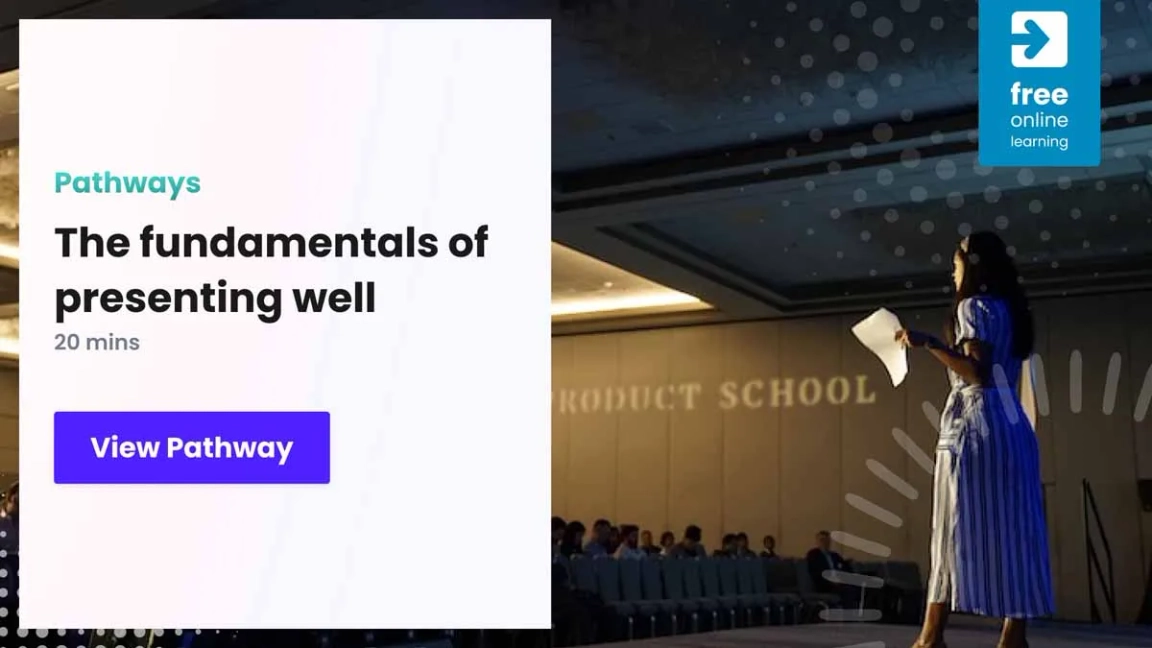Interviews and assessment centres
Deliver a presentation that's worthy of a graduate job
25 Jan 2023, 13:39
If the thought of speaking in front of a mixed group of candidates and assessors fills you with dread, follow our pointers for a perfect presentation.

Most assessors tell us that candidates who are asked to give a presentation as part of an interview or assessment centre do well – it is typically the exercise that they are strongest at. Many students, however, tell us that this is the exercise that they are most nervous about. So, in this article, we:
- explain the type of presentations you may be given
- advise you on the essential preparation required to create one
- give you our top tips on how to present in an impactful, professional way
And your specialist subject is… presentation topics for graduates
You’ll be given one of two types of presentation at an assessment centre, whether it is held in person or virtually:
- An individual presentation that you prepare in advance. You will be given a brief for this, which will tell you what it should be about and how long it should be. You could be asked to prepare something about you, for example a hobby or interest that you are passionate about or about your dissertation/final-year project. Alternatively, you might be set a ‘business problem’ related to the sector and required to present your solution.
- An individual or group presentation that you’ll be set on the day. This is usually given as an add-on to a case study exercise, in which you are asked to present your conclusions or recommendations from the case study to the assessors and other candidates.
At a job interview (no matter whether it is held over a video platform or in person) you will be given option 1 and will usually only be presenting to your interviewers.
If you have a choice of topics, choose a subject you know or understand well. Don't go for something you are less familiar with because you think it will be more impressive. It is better to present confidently on a simple topic with which you feel comfortable.
Embrace your inner-Sherlock Holmes… how to prepare for presentations
Before we look at structure, confident speaking and dealing with visual aids, the biggest tip we can give you is to find out as much as you can about what's required before the day. To give yourself the best chance, find out the following:
- the subject you will be talking on: this is usually provided in the brief, but do check if you are unsure about the scope.
- the length of the presentation and whether this includes time for questions.
- (if the assessment day or interview is held in person) the facilities and visual aids available or the equipment you will need: whether you need to bring a laptop, whether you will have wifi access etc.
- (if the assessment day or interview is held virtually) what platform you will be using, how to share a presentation on it, whether you should email your presentation to the recruiter in advance etc.
- who you will be speaking to and their level of knowledge and expertise in the subject. This will help you pitch your talk at the right level. If you are presenting the results to a case study, the assessors often play the role of a client or board of directors and you should tailor your content appropriately.
Then start with your presentation's structure... make it memorable
Giving your presentation a good structure will make you feel less nervous on the day. A structure is helpful to the audience too. It helps them know where they are and what's to come.
Give your presentation a beginning, middle and an end. At the beginning, welcome your audience and set the scene: let your audience know what you will cover.
If you have five-minutes your middle section will take about three of them. That's enough for two or three main points.
Don't try to cram in too much detail: a few points, well made, is best. You might want to break it into three memorable points you want your audience to take away with them. Remember what it feels like to listen to a speaker. Too much information and you begin to switch off. Prune your talk to the essentials.
The end should be a summary of what you have covered. Invite questions from the audience and when that's finished, thank them for their attention.
The visual aids… how much is too much?
How many slides or pieces of paper should you have? This entirely depends on the topic and length of the presentation, how much information you put on each slide and how many slides you need to make your point well. As a general rule of thumb, however, your presentation should be book-ended by:
- a title slide
- an introductory slide outlining what you will cover
- a final ‘thank you and any questions?’ slide.
In between, you probably only need one or two slides per main point you are making (so between two and six for a five-minute presentation). You can use more if it would better illustrate your points, but remember the need to keep to time.
If you are asked to prepare a presentation in advance and you are given the choice about whether to create visual aids, always do so. It will make your presentation more memorable to the audience.
The visual aids... pretty makes an impact
Be ruthless with the content: your entire talk shouldn’t be crammed onto slides or flip chart paper. Rather, they are to summarise those memorable take-home points we mentioned earlier. A clear heading and a couple of bullet points is plenty. Consider using simple diagrams, charts or graphs to illustrate your points. Keep the design style straightforward and professional (no Comic Sans).
Step into the spotlight… body language and voice tricks
Most of the message of your talk will be transmitted by how you say it. Some of the points below will be most useful for in-person assessment centres, while others will also relate to those that are held virtually. You can still maintain confident body language and control your tone of voice while speaking into your laptop, for instance.
- A welcoming smile is good for both you and the audience.
- Less experienced presenters have a tendency to speed up as they talk: try to speak clearly and at a measured pace. If you feel yourself start to rush, pause and get yourself back on track.
- Emphasise the really important points of your presentation by dropping your tone of voice at the end of statements. It’s what linguists call a ‘late dipping tone’ and sounds authoritative. A famous late dipper was Winston Churchill, which is why other politicians try to mimic him.
- Think about how and if you will move during your presentation. Keep hand gestures smooth, try not to fidget and keep your head up so that you don't talk to the floor.
- Don't talk to visual aids: when you feel nervous, this is very easy to do! Keep your eye contact on the audience.
- Try to engage with your whole audience by presenting to everyone on the panel.
Record yourself practising your presentation so that you can analyse your body language and tone of voice.
Step into the spotlight... don't start until you are ready
If you're nervous, your body will scream at you to begin and get it over with. What tends to happen next is that you start when neither you nor the audience is ready. Take your time. Before you say anything, pause, take a couple of calm, deep breaths and look around the audience (if the assessment centre is virtual, you may see them on your screen). When they are settled and ready, you can begin.
Practice is essential for an effective presentation
Practising a presentation is really cringe-worthy, but you must do it.
- Practise your presentation out loud, so that you are comfortable speaking from memory with only the need for the brief prompts on screen or on index cards.
- Practise your presentation out loud so that you feel comfortable with the timing and speaking at a measured pace (it is a cardinal sin to miss time a presentation and run over).
- Practise your presentation out loud so that you feel comfortable projecting your voice.
Try to anticipate the type of questions you might get from your audience and think about how you will respond to these. Do a final dress rehearsal the day before so that you are happy that everything works well together.
You might find it helpful to practise for presentations and other types of assessments.
targetjobs Editorial advice
This describes editorially independent and impartial content, which has been written and edited by the targetjobs content team. Any external contributors featuring in the article are in line with our non-advertorial policy, by which we mean that we do not promote one organisation over another.












